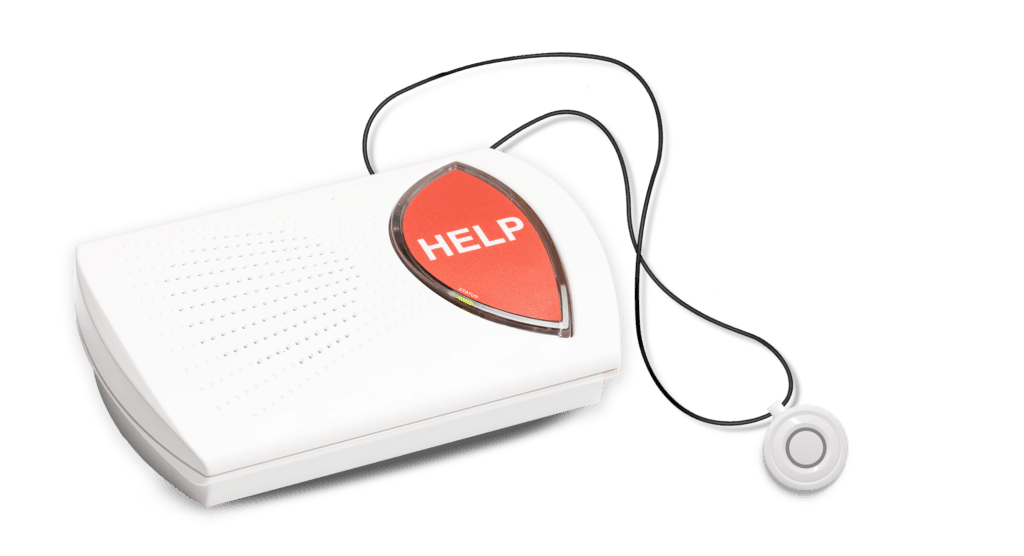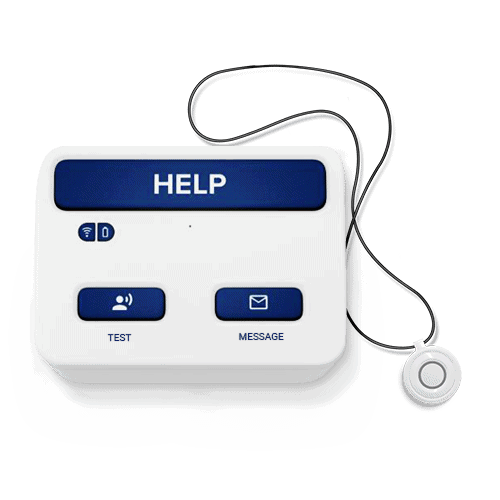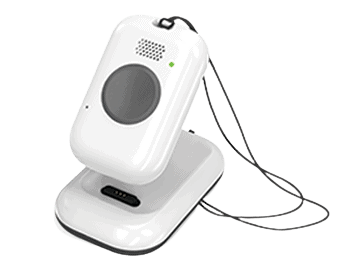Medical Alert System Review
Medical Alert offers four systems for at-home and on-the-go use with prices starting at $27.95 per month.
SeniorLiving.org is supported by commissions from providers listed on our site. Read our Editorial Guidelines
SeniorLiving.org is supported by commissions from providers listed on our site. Read our Editorial Guidelines
Medical Alert combines reliable technology with simple functions to come to your aid as quickly and efficiently as possible. For this review, I tested the Home System and Mobile System to see how they hold up compared to other competing brands. I found that the products were high quality and reliable.
Medical Alert doesn’t charge extra fees or hold you to long-term contracts, and with their 30-day free trial, it’s easy to give Medical Alert a test run. Not everything was rosy, though; for instance, the at-home unit could use better audio controls, and the company’s product lineup is pretty limited. That said, I’ll share my experience with the company, their medical alert products, and the perks and qualms I had.

Pros and Cons
Pros About Medical Alert
- Excellent response times: Medical Alert has fast response times, which is a critical measure of safety for medical alert systems.
- No hidden fees: Medical Alert eliminates all equipment, activation, and installation fees and only charges for monthly subscriptions. Other companies we've reviewed, such as Lifeline, have pricey activation fees.
- 30-day free trial: Committing to a product before you’ve had the chance to test it can be stressful, so Medical Alert gives you 30 days to test your device.
- Discounts and promotions: Medical Alert offers seasonal discounts throughout the year to help you save.
- Useful caregiver app: Medical Alert Connect is a free app available with every system. It offers, among other things, location detection for caregivers.
Cons About Medical Alert
- Limited product variety: Medical Alert’s products are limited to four systems with a small number of add-ons for customization. If you prefer more high-tech equipment or variety, check out our latest Bay Alarm Medical review and this year’s Medical Guardian review.
- No volume control on base units: When I tested the Home System, the base unit’s volume wasn’t as loud as I’d hoped. Older adults with hearing loss might find the lack of volume control a drawback.
- Mobile device not an all-in-one: Fall detection is available only through a separate neck pendant rather than being programmed into Medical Alert’s mobile device.
- Limited range for at-home systems: Range refers to the maximum distance at which the help button can communicate with the base unit. For Medical Alert, this distance is 800 feet, which is somewhat limited.
- No free shipping for monthly plans: Unfortunately, Medical Alert doesn’t offer free shipping on its monthly plans, so you’ll have to pay a fee. Free shipping is available on semiannual and annual plans.
How Does Medical Alert Compare?
Medical Alert offers peace of mind and fast access to medical services in an emergency. With no hidden fees and plenty of discounts available, Medical Alert is a solid choice for your medical alert system. There are, however, other providers with larger, more diverse product lines. If you want more options to choose from, view our top-rated medical alert brands below.
Overview of Medical Alert
The Buying Experience
Clicking around Medical Alert’s website is fine, but I recommend calling them for help with choosing a system that works for you. When I called, an agent named Joe answered the call after about 15 seconds.
Money Saver: If you sign up for Medical Alert’s semiannual or annual payment option, your rate will drop by a few dollars per month. In addition, with the semiannual subscription, you receive free ground shipping. With the annual subscription, you receive free shipping and a free lockbox.
I was curious about the free lockbox that’s included with the annual subscription. I asked Joe if they sold the lockbox separately, as I was considering the monthly payment plan, which doesn’t offer a free lockbox. To my surprise, he said that he could offer it to me for free anyway.
In my experience, chatting with a sales agent has frequently helped me knock off a few excess fees, like shipping or activation. In this case, I ended up with a free lockbox! Keep in mind that deals and discounts are constantly changing, so this offer might not always be available. However, it’s worth checking with customer service to see.
Setting Up My System
After receiving my systems in the mail, which took about a week, my package came with the Home System base unit, a help button with a neckband and wristband, the Mobile System’s wearable unit, and a charging cradle.
Pro Tip: Want to compare Medical Alert to other top providers? Visit our list of the best medical alert systems for seniors in 2024.
Home System Setup
I set up my Home System by unplugging the cord from my landline phone in the living room and plugging it into the port labeled “Wall Jack” on the back of the base unit. Then, I took the telephone cord that came with the system and plugged one end into the base unit’s “Phone” port and the other into the back of my phone. The final plug-in was the power adaptor, and I made sure not to insert it into a light switch outlet. Once that was done, I powered on the base unit by sliding the on/off switch to On. The landline Home System has an 800-foot range, so it’s important to keep the base unit in a centralized area of your home near a phone jack.
A steady green light indicated that the system was on. To ensure that the system was fully functional, I dialed the testing line number and requested my account to undergo “Test” mode for 15 minutes. After following the automated voice prompts, I hung up and pressed the wrist help button. I knew the base unit received and verified the signal by the green light that appeared on my wrist help button after a few seconds.
Mobile System Setup
As for the Mobile System, I plugged the charging cradle into an outlet, and a green light appeared on the charger, which meant that it was up and running. Then, I placed the device onto the cradle, and the power light and signal indicator began to flash before the device announced, “Your device is now charging.” The signal indicator then illuminated green. I left the Mobile System in its cradle for a few hours, and it was fully charged.
To complete the setup, I needed to download the Medical Alert Connect app, which gave me access to the status of my devices, contact lists, and testing schedules. The app also enables location detection for caregivers. Medical Alert encourages customers to test their systems weekly to ensure they are in top form.
Contracts and Warranty
Remember Joe, the customer service rep I spoke with? During our conversation, I asked about Medical Alert’s product warranty, since it wasn’t posted on their website. Joe said that they will send a replacement at any time for equipment that is faulty due to normal wear and tear. For protection against lost, stolen, or damaged equipment, Medical Alert offers a protection plan for an additional $5 per month.
In addition, all Medical Alert systems include a 30-day free trial. This means you can cancel your subscription and return the equipment within 30 days to receive a full refund. If you cancel after the first month, no problem. Medical Alert doesn’t require long-term contracts, so you can cancel your service for a prorated refund at any time.
Medical Alert Systems at a Glance
| Medical Alert product | Features | Starting price* | Connection type |
|---|---|---|---|
| Home System (Landline) | – Two-way speaker communication via the in-home base unit – Water-resistant emergency pendant or bracelet – Base unit with 24/7 professional monitoring – Optional fall detection |
$27.95 per month | Landline |
| Home System (Cellular) | – Two-way speaker communication via the in-home base unit – Water-resistant emergency pendant or bracelet – Base unit with 24/7 professional monitoring – Optional fall detection |
$37.95 per month | Cellular |
| Mobile System | – 24/7 professional monitoring – Handheld mobile device – Black carrying case – Interchangeable neck and wrist options for help buttons – GPS location services – Two-way talk – Optional fall detection |
Standard: $42.95 per month Mini: $47.95 per month |
Cellular |
| Smartwatch | -24/7 professional monitoring -GPS tracking -heart rate monitor – Step tracking -Otional fall detection – Voice prompts -Waterproof |
$39.95 per month + $159 equipment fee | Cellular |
* Discounts are available for semiannual and annual payment plans.
Medical Alert System and Product Details
Home System (Landline)
Cost
Overall, Medical Alert’s prices are fairly affordable, especially if you opt for an annual or semiannual plan. The landline model of the Home System is the cheapest package, with plans starting at $27.95 per month. It includes the same benefits as the cellular system, so for older adults who have a landline, need an at-home system, and want to save $10 per month, this landline system is a good option.

Medical Alert Landline
Equipment
My Home System came with a base unit and wearable help button. The landline system has a range of 800 feet between the base unit and the help button. As a point of comparison, MobileHelp, which you can find in our review, has a 600-foot range for its at-home landline system.
I live in a one-story home, so I wasn’t too worried about my help button being out of range from the system’s base unit. To be safe, I walked to different areas of my house to make sure that the connection was strong and reliable. Sure enough, the green light stayed steady after pressing the button several times throughout the house and waiting for three seconds.
FYI: Medical Alert Connect is a free app available to all subscribers and caregivers that you can download on a smartphone or other smart device. It enables caregivers to track an older loved one’s location and receive notifications if a loved one has pressed the help button.
My other concern with the Home System was the base unit’s two-way speakerphone. While I was in the kitchen, I tested the wrist button to see if I could hear the operator, despite not being near the base unit. I found that the operator’s voice was quieter than I’d expected. I have pretty good hearing; older adults who have hearing loss will need to ask the operator to speak up. Volume control for the base unit would be nice, considering 1 in 3 people between the ages of 65 and 74 experience hearing loss.1
Service and Monitoring
While testing the system, I pressed the wrist button, and the base unit responded by saying, “Emergency,” before contacting a live operator. Once I was connected with someone, the unit announced, “Emergency reported.” It only took about 12 seconds for a live operator to get on the line with me. That is a fantastic response time! When I told them that I was testing the system, the operator asked for my name before letting me know that it was no problem.
The Home System offers fall detection for an additional $10 per month (which is in line with what others in the industry charge). If you opt for it, you will receive a special pendant that includes both fall detection and a help button.
Home System (Cellular)
Cost
The cellular version of the Home System costs $37.95 per month. Because it’s $10 more than the landline system, though it has all the same features and benefits, it’s best for homebodies who don’t have a landline. Otherwise, you can save on your monthly bill with the landline system.

Medical Alert Cellular
Equipment
Like the landline system, the cellular Home System has a base unit and a help button worn on a neck lanyard or wristband. Unfortunately, the range is not any greater with the cellular system than it is with the landline system – 800 feet. This could be limiting for some older adults, depending on the size of their home and yard. However, if it works for your home, this system is a reliable, straightforward option.
Setup for the cellular system requires fewer steps than the landline model; you plug the power cube into an outlet that doesn’t control a light switch. Once turned on, the system’s base unit will announce “System initializing” before stating, “System ready.”
Service and Monitoring
Medical Alert’s systems run on AT&T’s cellular network. The company provides the connection, so you don’t need to be an AT&T customer. I’d recommend ensuring that you have strong AT&T coverage in your area before purchasing this system.
FYI: While fall detection is an excellent add-on for those at high risk of falls, it’s important to know that the technology isn’t 100 percent accurate. If you are able to press your help button after a fall, make sure to press it just in case, even if you have automatic fall detection.
You can add a fall-detection pendant to this system for an extra $10 per month. Automatic fall detection is excellent for seniors at higher risk of falls or those who want additional protection. Even if you’re unable to press your help button after a fall, this pendant calls for help automatically.
Mobile System
Cost
The Mobile System, Medical Alert’s only on-the-go option, comes in two versions: Standard and Mini. The Standard costs $42.95 per month, while the Mini costs $37.95 a month. So, for just $5 more, you can get the Mini option, which comes in a smaller and more lightweight design that you can wear all day comfortably and discretely.
I’ve found that monthly fees for on-the-go systems from other providers typically run between $35 and $40 per month, so Medical Alert’s standard version is at the lower end price-wise, but both are within average range. You can also add fall detection to this system for an additional $10 per month.

Medical Alert — Mobile System
Equipment
The Mobile System is a small mobile device that can be worn like a necklace. This system also comes with a necklace help button. Because it’s portable and you can take it anywhere, I recommend it for active older adults. Whether you take walks, grab lunch with friends, or golf, you’ll be protected. The Mobile System contains everything you need – a built-in help button, two-way talk, and GPS location tracking – all in a lightweight and discreet design. The Mobile System can also act as a base unit with a two-way speaker, while the wearable help button can be worn as a bracelet or necklace. The system has flexibility, serving older adults both at home and on the go. And while most mobile devices have batteries that last a day or two, the Mobile System has an extended battery life of up to five days.
Pro Tip: If you prefer an all-in-one mobile device, read our LifeFone review, or check out our top picks for the best medical alert systems with fall detection.
To test the Mobile System, I pressed and held the button until I heard a beep. The device announced, “Dialing emergency response center now. To cancel this call, press and hold the emergency call button for three seconds now.” I waited on the line, and as it rang, the device determined my location before connecting me with a live operator. I let them know that I was testing, and they verified my location and that my system was working correctly before hanging up.
Service and Monitoring
This hybrid system uses AT&T 4G LTE and includes two-way talk, GPS location detection, and optional fall detection. If you opt for fall detection, it will be included on your help pendant.
Smartwatch
Cost
The Medical Alert Smartwatch costs $39.95 per month (with a $159 one-time device fee). It features GPS tracking, giving you access to a trained response specialist whenever you need them. The Smartwatch is best for seniors with active lifestyles, seeking a simple device with discreet access to emergency staff, whenever they need it.

There are many smartwatches to choose from on the market, depending on your needs and budget. In comparison, the Apple Watch Series 10 is the most advanced smartwatch Apple offers. It can generate an EKG, which can be useful to seniors with arrhythmia or heart disease. The Apple Watch 10 series costs $399. It also has fall detection and a one-tap SOS button that connects you with emergency staff. Plus, it pairs nicely with your iPhone.
Equipment
The Medical Alert Smartwatch can help seniors manage their health with features like a heart rate monitor, step tracking, and optional fall detection. Plus, the Smartwatch will vibrate and talk when an emergency call is placed, there’s a low battery status, or when your device is charging.
Fun Fact: Around 224.31 million people worldwide own a smartwatch. Of those smartwatch owners, around 92 percent use their watch to manage health and fitness. 2
The Smartwatch has an adjustable wristband, charging base, charging cable, and power adapter. It also is waterproof, which is good for seniors who may be concerned about falls in the showers (or forgetting to take it off when they bathe!). Similar to Bay Alarm Medical’s SOS Smartwatch, it features GPS, step tracking, and a mobile app. The Smartwatch’s square shape makes it look more like an Apple Watch, while the SOS Mobile is round.
Service and Monitoring
The Smartwatch uses AT&T 4G LTE, two-way talk, and GPS location detection, along with optional fall detection for an additional $10 a month. For comparison, fall detection comes standard with the Apple Watch, but there is no 24/7 monitoring center, and you’ll pay a monthly fee for cell service.
Add-on Features and Accessories
Medical Alert doesn’t have a lot of accessories, like some other providers, but they do offer the essentials. We’ll take a look below.
Fall Detection
Priced at $10 per month, automatic fall detection is a great add-on. It’s designed to detect falls even when you aren’t able to press the button. If you hit your head and become unconscious or are otherwise unable to call for help, Medical Alert will send first responders if they are unable to get in contact with you.
Protection Plan
The Protection Plan ($5 per month) isn’t the same as a warranty, since the former covers lost, stolen, or damaged equipment. Knowing that I wouldn’t have to shell out hundreds of dollars for a replacement is worth the low monthly rate. Plus, Medical Alert often runs promotions that offer the Protection Plan for as little as $1 per month!
Lockbox: Included, not sold separately
When I received my free lockbox with the Home System, I set up the code and contacted Medical Alert’s customer care team. After registering the lockbox on my account, they let me know that if they needed to dispatch EMS, Medical Alert would send them the code. That way, first responders wouldn't have to break down my door.
To give you an idea of the value of Medical Alert’s complimentary lockbox, other medical alert providers typically charge between $25 and $30 for this add-on.
Medical Alert vs. The Competition
There’s a good number of medical alerts on the market for aging adults that boast a variety of features. Here is a quick look at the competition.
Medical Alert vs. Bay Alarm Medical
Bay Alarm Medical systems start at $24.95 per month for in-home systems and $29.95 for mobile systems, making them slightly more affordable than Medical Alert’s systems. Similar to Medical Alert, the company offers a 30-day risk-free trial, fall detection for $10 per month, a mobile app, and no long-term contracts. Bay Alarm Medical’s equipment is also more sleek and modern than Medical Alert.
Medical Alert vs. Medical Guardian
Medical Guardian has five different systems and requires no long-term contracts. While Medical Alert offers a companion app, the MyGuardian app from Medical Guardian is a bit more advanced. For example, unlike the Medical Alert Smartwatch, the MGMove lets you send messages and reminders to the watch using the app. Medical Guardian’s prices start at $32.95 per month, making them slightly pricier than Medical Alert. However, their more advanced systems may justify the higher cost. Medical Guardian doesn’t offer a free trial, so that’s an area where Medical Alert has a leg up.
Medical Alert vs. MobileHelp
MobileHelp systems start at $24.95 a month, so they’re a few dollars cheaper than Medical Alert’s starting rates. MobileHelp offers mobile and in-home systems with free activation and equipment, while Medical Alert has some equipment fees. No long-term contracts are required with MobileHelp, but they don’t offer a risk-free trial like Medical Alert does. MobileHelp also offers a few systems designed for two users, which is great for couples or roommates.
The Bottom Line on Medical Alert
Medical Alert’s systems offer fast response times, easy setup, and affordable monthly rates. I appreciate the company’s seasonal promotional offers, contract-free plans, 30-day free trial, and lack of extra fees. What you see is what you get, and they make it easy to try out their systems without any risk.
I would like to see Medical Alert’s in-home systems with a longer base-to-button range, but overall I was satisfied with the products I tested and would recommend the company to those who want a simple system.
Our Methodology
At SeniorLiving.org, we thoroughly research every provider that we review and their offerings. We then conduct hands-on testing whenever possible. While testing these systems, we rank them for several key categories, including price, value for money, response times, ease of use, quality of customer service, equipment quality, and available features. Then, we rate every provider a rating out of five stars based on our experience with the systems. We also receive feedback from seniors about the medical alert systems we review whenever we can. Our goal is to make every review as comprehensive as possible, so users form an opinion without bias. You can read our full medical alert system methodology guide to learn more.
Here’s a look at how our team evaluated Medical Alert and some of the factors we used:
- Cost: We evaluated upfront fees, equipment costs, monthly subscriptions, hidden fees for additional features, and contract terms such as flexible, no long-term contract options.
- Features and functionality: We looked at the range of devices offered, such as pendants, wristbands, or smartwatches. We evaluated fall detection options, GPS tracking, two-way communication, and activity monitoring.
- Monitoring services: We examined their 24/7 monitoring, average emergency response time, and multilingual support. Having a strong monitoring service is an important feature for older adults to receive help as quickly as possible.
- Customer support: We evaluated customer support availability, modes of contact such as email, live chat, and phone, as well as customer reviews to inform our evaluation.
Frequently Asked Questions
-
How much does Medical Alert cost per month?
Each Medical Alert system offers three tiers for monitoring subscriptions: monthly, semiannually, and annually. Prices start as low as $27.95 per month and range up to $47.95 per month, and there are discounts available for annual and semiannual plans.
-
What is the return policy for Medical Alert?
You can cancel your subscription at any time and return the equipment within 30 days to receive a full refund. Equipment received after 30 days will result in a prorated refund.
-
Can there be multiple users for each Medical Alert system?
Yes, you can purchase additional buttons or pendants without paying for additional monitoring subscriptions.
-
What do I do if I am moving to a new location?
Contact Medical Alert’s customer care team through an online form on the company’s website or by calling them. You can update the information on your account, including your address.
National Institute on Aging (NIA). (March 2023). Age-Related Hearing Loss (Presbycusis).
Demandsage. (2024). Smartwatch Statistics 2024: Worldwide Market Data.





